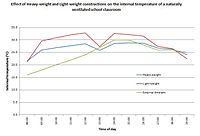
Photo from wikipedia
Thermal inertia has been applied to map soil water content exploiting remote sensing data in the short and long wave regions of the electromagnetic spectrum. Over the last years, optical… Click to show full abstract
Thermal inertia has been applied to map soil water content exploiting remote sensing data in the short and long wave regions of the electromagnetic spectrum. Over the last years, optical and thermal cameras were sufficiently miniaturized to be loaded onboard of unmanned aerial systems (UASs), which provide unprecedented potentials to derive hyperspatial resolution thermal inertia for soil water content mapping. In this study, we apply a simplification of thermal inertia, the apparent thermal inertia (ATI), over pixels where underlying thermal inertia hypotheses are fulfilled (unshaded bare soil). Then, a kriging algorithm is used to spatialize the ATI to get a soil water content map. The proposed method was applied to an experimental area of the Alento River catchment, in southern Italy. Daytime radiometric optical multispectral and day and nighttime radiometric thermal images were acquired via a UAS, while
Journal Title: IEEE Transactions on Geoscience and Remote Sensing
Year Published: 2021
Link to full text (if available)
Share on Social Media: Sign Up to like & get
recommendations!